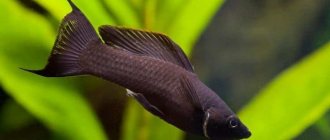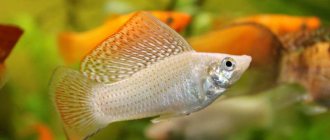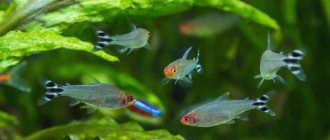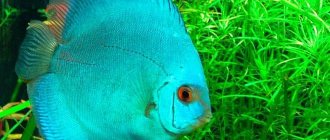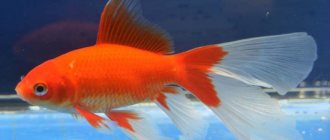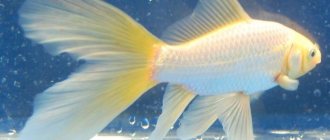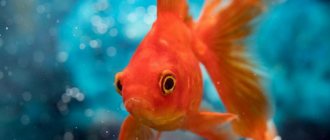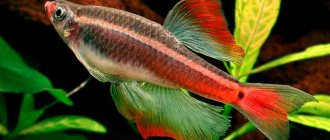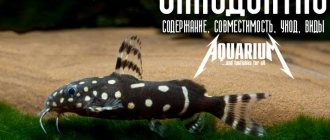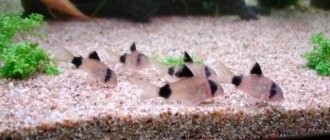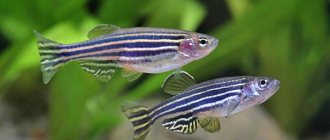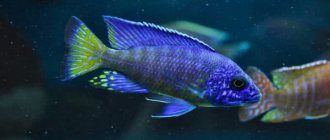Mollies are beautiful and unpretentious viviparous aquarium fish. It is popular among beginners and is interesting as a breedable species for professionals. It coexists well with a lot of other fish and is able to decorate any aquarium.
| Full name | Mollies/Poecilia |
| Kinds | Mollies sphenops, velifera, latipina, petenes, free-ranging, dwarf, golden, silver, marbled, balloons, lyretails |
| Color | Black, white, yellow, red, silver blue |
| Water | Volume per fish – 10 liters PH (acid-base balance) – 7-8 KH (hardness) – 10-20 t (temperature) – 25-28°C |
| Feed | Live food - bloodworms, tubifex, coretra, daphnia, gammarus and brine shrimp; frozen food of the same types; feeding from boiled and crushed eggs, meat, liver, sea fish; plant food - tablets and flakes with spirulina algae, blanched vegetables, dried herbs, crushed oatmeal and semolina; dry food, balanced in terms of vitamins, minerals and fiber - Tetrapro Algae, Tetra Phyll and Tetramin Flakes |
| Compatibility | Viviparous - gupeshki, swordtails, platies; labyrinthine - lalius, gourami; spawners with a calm character - zebrafish, thornets, angelfish, barbs |
| Priming | It doesn’t matter, for black species light is better |
| Plants | Fast-growing species with hard leaves - Vallisneria, hardleaf arrowhead, Java moss, Riccia, Elodea, water cabbage |
| Scenery | Shelters – driftwood, weathered rocks, grottoes or caves |
| Lifespan | They live in an aquarium for 3–5 years |
History of appearance
In 1846, the French zoologist Achilem Valencoen first described the mollies sphenops. More than 50 years later, the famous ichthyologist-taxonomist Charles Tate Regan made a description of the velifera and free mollies.
Mollies arrived in Europe only in 1913. And active breeding work begins after 7 years. As a result, many different hybrids appear.
Mollies are rapidly gaining popularity among aquarists. The most popular and recognizable is the black breed, obtained by German breeder Bill Stericke, who took 11 years to breed an absolutely black fish.
Habitat in nature
Its natural habitat is almost the entire American continent. The fish are found in fresh water bodies, as well as in the mouths of rivers flowing into the ocean.
This is where fresh and salt water meet. But some species have adapted perfectly to such conditions. The natural habitat of fish is quite wide:
- Sphenops is found in bodies of water from Mexico to Colombia.
- Velifera lives in Mexico on the Yucatan Peninsula.
- Latipina prefers reservoirs located in the southern states of America (Florida, Texas, Virginia, Carolina) and loves brackish water.
Mollies can eat absolutely any food, while they are unpretentious to living conditions and are viviparous fish. Thanks to this, they were able to develop fairly large tropical areas of South and Central America.
Reproduction of aquarium species occurs on special farms, which are also located in the countries of Southeast Asia. It is from there that they go to different parts of the planet for sale.
Diseases
Mollies have average immunity. They can easily catch diseases and make the entire aquarium sick.
These fish are sensitive to the level of oxygen in the water. At excessive temperatures, the amount of oxygen is reduced and the fish becomes lethargic. There are also cases with an excess of oxygen (for example, when replacing too much water with fresh tap water). Then the fish may experience a gas embolism (darkening of the gills, restlessness). It goes away on its own over time when the oxygen level in the water returns to normal.
Under unsuitable conditions, the mollies' immunity fails, and tumors begin to grow on the body. At first they look like multi-colored spots, then they degenerate into tumors. The disease is called melanosis and cannot be treated.
In addition, mollies are prone to standard fungal aquarium infections such as ichthyophthyriasis (semolina).
Under good conditions and stable water parameters, mollies do not get sick, live as long as possible and produce healthy offspring.
Description and appearance
In an aquarium, the average lifespan of mollies is no more than 5 years. Females can grow up to 12 cm in length, while males do not exceed 8 cm.
The main characteristic features of the appearance of mollies:
- the body has an elongated shape in length, as if slightly compressed at the sides;
- the eyes are large, the head is not very large;
- most species have short fins (the exception is the velifera, which is characterized by a highly developed dorsal fin with a rounded edge);
- Thanks to long-term selection work, the coloring is very diverse.
The appearance of the fish may differ depending on the specific species (the balloon mollies have a short body, a convex abdomen, etc.)
Popular natural species of mollies
Fish are widespread. But there are several natural species of mollies that are popular and in demand among aquarists:
- Sphenops. The species has a dense body, slightly flattened on the sides. The fins, including the tail, are small and neat, rounded at the edges. The body length varies within 11 cm. The natural color is not very attractive - the upper body is grayish-green and the lower part is silver-gray.
- Dwarf. The fish got its name due to its small size. Individuals do not grow more than 4 cm in length. Dwarf mollies are yellowish-brown in color, with golden dots on the sides. The dominant male's scales have a blue-metallic sheen. But the sign does not always occur.
- Pétain. Mollies got their name due to their location - Lake Peten Itza, located in Guatemala. The fish has a silver-pearl color and has a red border on its fins. Males have a characteristic sword-shaped process at the bottom of their tail. Because of this feature, the peten molly is often confused with swordtails.
- Freestyle. For a long time, based on color, the species was considered a variation of Sphenops. Over time, free mollies were assigned to a separate group. Body color is grayish-yellow. Males have a carmine orange tail and fins with noticeable black speckles on their surface. In adult males, the color is brighter and more saturated. The tail and fins of females are gray.
- Latipina (broadfin). The species has a certain similarity with Velifera molly, but is smaller in size. Individuals grow no more than 10 cm in length when kept in aquariums; in nature they reach 17 cm. The upper high fin has the shape of a rectangle. The body is brownish-silver in color, with bluish/dark speckles. The belly is orange, the central part of the fins is blue, there are strokes and dots, and the edge is orange.
- Velifera (sailing). Males have a high upper fin, which is why the species got its name. These mollies are the largest. Females reach a length of 15 cm.
The color is silver, there are intermittent longitudinal lines. The belly and head of males are orange. In the center of the orange tail there are blue specks, along the edges there is a turquoise stripe. The upper fin has a black or orange border. Females have a grayish-green color throughout their entire body, including their fins. Along it are broken lines of a darker shade.
Compatibility
Peacefulness is another positive characteristic of mollies. It makes them convenient for keeping in community aquariums. At the same time, in order to avoid conflicts within the mollies flock itself, it should be dominated by females at the rate of 3-4 females per male. When choosing neighbors, it is recommended to give preference to fish that are similar in size. The fish get along well with zebrafish, catfish, and ancistrus.
All species, except Velifera, are able to get along with barbs. To keep them in a community aquarium, take care to arrange shelters made of driftwood and grottoes. Neighborhood with aggressive species, such as cichlids, is not recommended.
mollies compatibility table
Breeding forms of mollies
With a great variety of relatives, aquarists give preference to bright hybrids bred artificially.
Popular varieties:
- Lyrebirds. The structure of the tail is the main feature of this species. Its outer rays are much longer than the middle ones. At the rear edge of the tail, a curve is formed that resembles the outline of a lyre. Fish can be of almost any color, but it is impossible to single out just one as the main one.
- Cylinders. During the breeding of the hybrid, breeders selected individuals with the shortest possible body. This approach made it possible to obtain fish with a truly unique body structure that looks like a small balloon. Balloons come in completely different shades.
- Marble. This is more of a color variation of the molly, but not a specific breed. A characteristic feature is a large number of irregularly shaped black spots on the body, which can even merge and stand out clearly against a yellowish-gray or white background. The predominant color is black. Due to the presence of dark spots, this form is easy to distinguish from the Dalmatian molly, but in this case there are significantly fewer of them.
- Silver (snowflakes). The group is characterized by a white body color with a pearlescent blue tint. The scales sparkle, reminiscent of snow under the bright rays of the sun. For this similarity, the fish received its name. Mollies grow no more than 10 cm in length.
- Gold. This group is quite large. It combines individuals with a bluish-white tint and a yellow-orange tint. Most representatives have expressive red eyes.
Popular aquarium species
There are many different species of mollies, bred specifically for growing in an aquarium. They differ in color, shape of individual body parts and size. The following varieties are distinguished:
- Black molly. The surface of the fish's skin is velvety. But the new generation, in most cases, does not look like its parents - individuals of a gray-yellow hue appear. Read more about this type of mollies here.
- Silver spotted molly (Dalmatian). Due to their color, these fish resemble the popular Dalmatian dogs. The scales are silvery-white, with pronounced black spots. The fish grow 5-14 cm in length.
- Red leopard. Very interesting representatives of the species. They attract attention with their unique appearance. The fish are characterized by a fairly intense base color with the presence of black spots.
- Yellow. This includes all sorts of shades of yellow. There are individuals with admixtures of red, white or black. The color of a particular fish will depend on both genetics and conditions of detention.
- Orange. A very interesting variety with a golden-orange body. The fish is about 7 cm long. Orange-colored individuals with a black tail are extremely rare.
- Coffee Velifera. The breed is considered rare and in demand. The fish has a very interesting brown-coffee color, the tail and fins are speckled.
- High-finned green. This is one of the color subspecies of the molly latipin. Very light color, almost colorless. There are many green spots on the body of the fish. Individuals grow no more than 6 cm in length.
- High-finned orange. Another subspecies of mollies latipin. The fish itself is a light orange hue, the abdomen has a brighter color. There are small spots of a delicate blue hue on the body. Dimensions about 8-13 cm.
- Two-color. The fish is painted in two colors. It is a hybrid species with a rich black tail and a bright warm body. Sometimes there are specimens with black scales, sprinkled with a gradient of yellow shades, reminiscent of gold dust scattered on top. They have black eyes with a very thin silver rim.
- Black lyrebird. The fish is one of the varieties of black molly. The main characteristic difference is the shape of the tail.
You can also learn about the types of mollies from the following video:
Fish diseases
The ailments of the individual, like other viviparous representatives of the water element, are associated with an imbalance in maintenance and feeding. The causes of the disease may include the following:
- deviations of temperature and acidity regimes of water from the normal level;
- periodic overfeeding of individuals;
- colds and infections;
- improper change of water environment;
- improper transportation of peace-loving fish.
The following pathological conditions indicate the disease:
- the appearance of local areas on the body covered with small bubbles and mossy formations;
- the formation of dark marks, light spots, tumor formations on the fins;
- general lethargy, irrational trajectory of movement, sinking to the bottom, refusal to eat;
- visual bulging of the eyes.
Diseases of Mollies
Mollies are most often susceptible to the following types of diseases:
- Change of color - melanosis, excess pigmentation turns into a tumor.
- Ichthyophthiriasis, or the so-called fish louse, is a parasitic attack on delicate scales.
- Invasive diseases.
- Ingestion of a foreign body. In this case, the molly begins to move extremely irrationally, often falling to the bottom head down.
- Exophthalmos is fish-like protruding eyes, often leading to loss of vision and death.
- Gas embolism. It is formed as a result of excess oxygen content in the aquatic environment. This phenomenon occurs when the tank is filled with unsettled tap water. The disease is characterized by restlessness and darkening of the gills. Care and therapy here takes place in the form of an urgent change of the aquatic environment.
- Melanosis. The body is covered with blots of non-standard color, which later transform into tumors. This pathology cannot be cured. Preventive measures consist of creating comfortable living conditions; this pathology can be solved in this way. Only tracking key indicators will help you avoid these destructive conditions.
- Cold. If lethargy and apathy appear in the behavior of individuals, they begin to swim near the surface, they experience loss of appetite, then all this indicates a possible cold. The disease attacks when the temperature drops. Care and therapy in this case consists of creating a comfortable temperature regime.
- Hexamitosis in mollies.
Why do mollies die?
Harmful ammonia, nitrates and nitrites begin to rapidly accumulate in the aquarium environment. All these harmful components have a detrimental effect on the protective properties of the fish’s body. It is extremely difficult to cure her of this condition. If timely measures are not taken, this entails the death of the individual.
If intoxication with harmful substances does occur, the following actions will help:
- Regularly change the cloudy liquid to purified water.
- Carrying out a test for the oxygen content in an aquatic environment, using it you can also find out the content of NH4, NO3, NO2. These actions will help bring the indicators back to normal.
- White spots on the body of an individual will disappear when the temperature in the aquarium increases, adding salt and effective antibiotics, increasing the temperature regime.
- If a specimen has bulging eyes, this can cause an infection. In this case, therapy may be required.
Treatment
The nearest pet store has effective remedies for various ailments. The main task of the aquarist is to accurately determine the symptoms. Many ailments arise due to an imbalance in living conditions:
- water filtration;
- necessary aeration;
- insufficient aquarium volumes.
When an illness is detected, the following remedies are often used:
- Effective Tetra Contralck against destructive ciliates, flagellated bacteria (ichthyophthiriasis, semolina, the appearance of white spots).
- Sera bakto Tabs help cope with internal bacterial infections.
Before using a particular medicine, study the description of its properties in detailed instructions.
Prevention
To avoid the development of an unwanted disease, preventive measures are mandatory:
- Regularly change dirty and stale aquarium fluid.
- Cleaning the tank.
- Temperature control.
All these measures will help not only revitalize the aquarium space, but also produce healthy offspring.
Features of care and maintenance
The beauty and health of pets is the result of the breeder’s attentive attitude. For fish, you need to choose the right container, equip it and provide appropriate care.
Choosing an aquarium
Fish like to live in small schools (no more than 10 individuals). Remember that one molly requires at least 9 liters of water. A 50 liter tank will be the optimal housing for a flock.
For sailing mollies, which are larger in size, a 100 liter capacity is needed.
The fish are very active. Pets jumping out of the water is not uncommon. Buy an aquarium with a lid.
Water requirements
These are heat-loving individuals. Consider important water parameters:
- optimal temperature indicators +24…+28˚С;
- reaction - slightly alkaline or neutral - 7-8 pH;
- hardness - from 10 and 20;
- A low salinity is desirable - no more than 2-3 g/l.
Mollies don't like dirty water. Once a week, replace about a fifth of the total volume using pre-settled liquid.
Equipment
When creating optimal conditions for mollies, equip the aquarium with the necessary equipment. Basic:
- filter;
- a compressor to saturate the water with enough oxygen;
- heater (constant temperature changes negatively affect molly);
- additional lighting is provided by installing lamps.
Soil, plants, decorative elements
Fish have a habit of actively and quickly eating plants. Place fast-growing flora in the aquarium with fairly tough foliage.
An excellent choice would be:
- Vallisneria;
- Java moss;
- Stiffleaf arrowhead;
- water cabbage;
- elodea;
- Riccia.
Place vegetation near back and side walls. In this case, the fish will have enough free space to move.
There are no special requirements for bottom coating. An excellent choice would be pebbles and sand, as they are great for plants. A layer is poured within 5 cm.
The decor will act as a shelter for females, weak males, and newborn cubs. You can use natural driftwood, large stones, or buy a cave or grotto. It is recommended to place several shelter options in the aquarium.
Feeding
The fish can eat absolutely any food. Both plant and animal foods are suitable. You can feed mollies:
- live food (tubifex, bloodworms, daphnia, artemia, coretra);
- frozen food;
- boiled eggs, meat, liver, ocean fish are good feeding options;
- plant food - flakes with tablets with spirulina algae, dried herbs, blanched vegetables, semolina and crushed oatmeal;
- dry food, which is perfectly balanced in fiber, minerals and vitamins.
Give food twice a day. Don't feed once a week. This will be a fasting day.
Compatibility
Mollies are very calm and friendly aquarium inhabitants. They get along well with almost any fish. Choose roommates of similar sizes. Excellent companions will be:
- zebrafish;
- rasboras;
- characins;
- Ancistrus;
- corridors.
Mollies live quite well “side by side” with barbs. But there is an exception - the velifera, since the male half has beautiful long fins that can be damaged.
If one aquarium will contain several species of fish at once, there must be shelter and a sufficient volume of water.
You should not keep mollies and cichlids together, as they are extremely aggressive. This applies even to large species of molly.
It is extremely rare that mollies - this applies specifically to representatives of large species - begin to chase other inhabitants in the aquarium.
How to choose the right fish?
When selecting a specific individual in a store, consider several simple but important parameters. These include:
- fish behavior - it must be active;
- appearance - absence of various signs of disease;
- the specific type and color is selected taking into account personal wishes.
All types of aquarium mollies have been developed through selective breeding. Each group has its own standards. Unscrupulous breeders use antibiotics and growth hormones to achieve them faster. However, such individuals will be weakened.
You need to purchase fish from trusted manufacturers with a good reputation.
Feeding
The diet of mollies consists of three main components:
- Protein food. There should be a little of it, it’s a tubifex, a bloodworm.
- Plant foods are the main part of the diet. It is to obtain natural vitamins that mollies eat live plants with pleasure. Without them, the fish’s immunity suffers significantly.
- Special dry food for viviparous fish helps maintain color, restore strength, and properly grow and develop. Dry food is the basis of the diet. For fish with this mouth shape, dry food is preferable to flake food, which does not sink immediately. The fish collects food from the surface.
Reproduction and breeding of mollies
The main advantage of fish is viviparity. This greatly simplifies breeding mollies at home. Even without the help of an aquarist and in a common tank, a pair of molly can produce offspring.
Males sometimes begin to compete with each other. To prevent this from happening, you need at least two females per male.
How to distinguish a male from a female?
The species has pronounced sexual dimorphism. Females are larger and thicker than males. The male has a gonopodium, which is absent in females.
Females reach sexual maturity at the age of 5-7 months, males are ready to reproduce at 9-12 months. If the flock contains representatives of approximately the same age, you will have to wait until the males grow up.
If females exist in a same-sex pack, they can change sex and become male. It is believed that this process is influenced by temperature fluctuations.
However, experts claim that this process only causes long-term maturation of males. Such males take much longer to develop sexual characteristics and are often called “late males.”
Preparing the spawning tank
To preserve the offspring, use a separate tank - a spawning tank. Mollies begin to reproduce if optimal conditions are created for them:
- water temperature +28˚С;
- slight salinity - take 1 tbsp per 20 liters of water. l. salt;
- feeding should be enhanced with an emphasis on food with a high content of microelements and vitamins;
- It is desirable to have decorative shelters and algae.
Additional information about the spawning ground, as well as the maintenance of mollies fry, can be found in the following video:
Selection of producers and breeding process
Future parents must be active and completely healthy. If the molly has external damage or defects, it is not suitable for breeding. To get a clean look, keep only one species in one tank.
Create suitable conditions, and the molly will begin to produce fry once every 1-1.5 months. Fish have internal fertilization, with the male using the gonopodium.
There are several features of molly breeding:
- pregnancy duration is approximately 1.5 months;
- signs of pregnancy - the female’s abdomen becomes square-shaped, a dark spot appears at the bottom at the back;
- before giving birth, the female actively hides in shelters and thickets of grass;
- most often spawning begins early in the morning;
- one female at a time can produce from 50 to 100 fully formed fry.
After the birth is complete, remove the female, as she is capable of eating the offspring herself.
Caring for fry
Mollies give birth to fairly large fry, but they begin to swim no earlier than a few hours after birth. At first, they simply lie on the bottom or leaves of plants.
Rules for caring for molly fry:
- change the water as often as possible, using only pre-settled and lightly salted water;
- give complete food - both plant and animal food are suitable, but previously crushed to a dusty consistency;
- Give food once every 2-3 hours.
Feeding the fry
Start giving food no earlier than the young animals begin to swim. First, introduce ciliates into the diet, then gradually add to the menu:
- cyclops;
- Artemia;
- spirulina;
- food of liquid consistency.
Give food in small portions. During the first days, the fry show virtually no interest in food. After a few days, the young animals begin to feed more actively.
“Live dust” brings benefits, as well as special types of food for fry. TetrMin Baby is perfect.
With proper nutrition and suitable conditions, the fry grow quite quickly. At the age of 1 month, they reach a length of about 2-3 cm. During this period, it is permissible to gradually move the young animals into a common aquarium. The fry are fully grown by the age of 4-5 months.
Reviews
Angelina, Moscow. Mollies are very beautiful and unpretentious aquarium fish. In my case, they reproduce independently in a community aquarium. The individuals are calm and peaceful, and have not been seen in fights with “neighbors.”
Valery, Krasnodar. I just love molly. The fish do not require any special conditions. It is enough to properly set up the aquarium once and just change the water periodically. The fish are active, but calm and very beautiful.
Mollies are simply ideal for beginner aquarists. Representatives of the species have a calm disposition and get along well with almost any type of aquarium fish. They do not require special attention, but will certainly delight their owner with beautiful and bright colors.
Price
The current retail market for aquarium fish offers the widest selection of species and color forms of mollies or, as they are correctly called on labels and price tags, platies. Fish of simple and common colors are sold at prices starting from 50 rubles. White molly , or “snowflake”, is already more expensive, costing 100-150 rubles. And so on.
Guppies, which sellers never mix with other species and sell as an independent variety, start at 90-100 rubles. Private breeders-sellers ask for a lower price than stores. Who has a better quality product, whose fish will live longer is unknown.
The final price is affected by the color; in addition, larger fish are more expensive. The size of the fish indicates not only and not so much the age, but rather the conditions under which the fish are kept. Breeders of aquarium fish keep them in crowded conditions. Only with decent maintenance do fish have a chance to grow to their nominal size.
